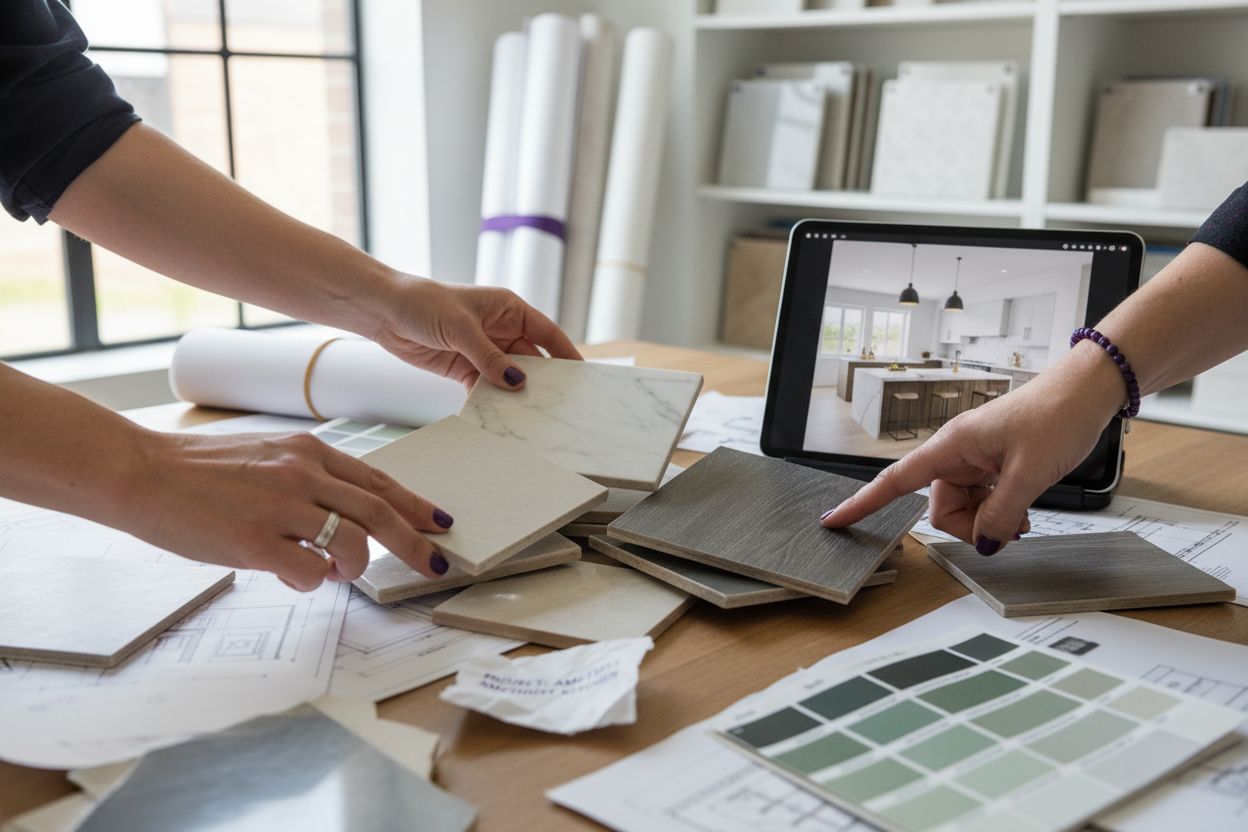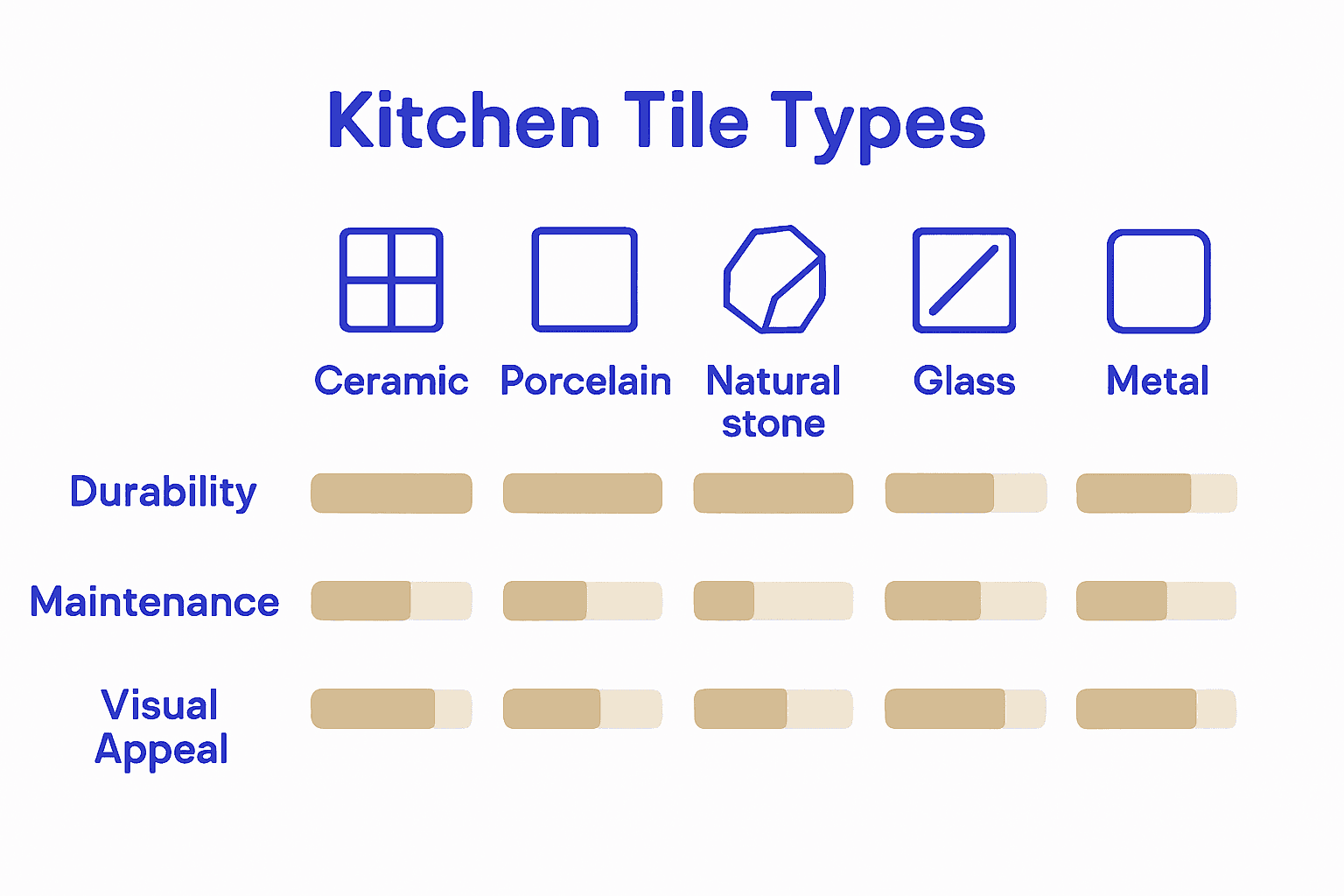The Essential Guide to Tile in Kitchen Design
Posted by Mike Belk on Oct 28, 2025

Did you know that over 70 percent of homeowners choose tile when renovating their kitchens? The right tile choices do far more than cover surfaces. They set moods, shape traffic flow, and impact how a kitchen feels and functions every day. Whether you crave a bold new style or want a hardworking space that stands the test of time, discovering how tiles influence modern kitchens helps you unlock the full potential of your home.
Table of Contents
- Defining Tile’s Role in Modern Kitchens
- Types of Kitchen Tiles and Their Uses
- Design Impact: Color, Texture, and Pattern Choices
- Installation and Maintenance Requirements Explained
- Cost, Durability, and Value Considerations
- Comparing Tile to Alternative Materials
Key Takeaways
| Point | Details |
|---|---|
| Modern Functionality | Tiles enhance kitchen aesthetics and functionality, acting as visual storytellers that express style and design intent. |
| Material Versatility | A variety of tile materials, including ceramic, porcelain, and natural stone, offer different durability and maintenance options suited to various kitchen environments. |
| Design Elements | Thoughtful selection of tile color, texture, and pattern profoundly influences kitchen space, creating visually appealing and personalized environments. |
| Investment Value | Tile selection should balance initial cost with long-term durability and maintenance requirements to enhance overall value in kitchen design. |
Defining Tile’s Role in Modern Kitchens
Tiles have transformed from purely functional surfaces to dynamic design elements that dramatically shape kitchen aesthetics and functionality. In modern kitchens, tiles serve multiple critical purposes beyond simple wall or floor coverage, becoming integral components of design language and practical performance.
Modern kitchen tiles act as visual storytellers, communicating style, personality, and spatial energy through their color, texture, and arrangement. Whether creating a sleek minimalist environment or a warm, rustic atmosphere, tiles provide designers and homeowners extraordinary flexibility in crafting precise visual narratives. Understanding the role of tiles in kitchen design reveals how these versatile materials can dramatically impact a space’s overall character.
Beyond aesthetics, contemporary tiles deliver remarkable functional benefits. They offer superior durability, easy maintenance, moisture resistance, and exceptional longevity compared to traditional kitchen surfaces. From porcelain to ceramic options, modern tiles withstand high-traffic areas, resist staining, and provide hygienic surfaces that are simple to clean. Which types of tile are best for kitchen flooring can help homeowners select materials perfectly suited to their specific lifestyle and design preferences.
The strategic selection of kitchen tiles transforms spaces from mere cooking areas into dynamic, expressive environments. By thoughtfully integrating tiles, homeowners can create surfaces that are simultaneously beautiful, practical, and uniquely representative of their personal style.
Types of Kitchen Tiles and Their Uses
Kitchen tiles represent a dynamic spectrum of materials, each offering unique characteristics that transform culinary spaces. Ceramic tiles emerge as the most versatile and budget-friendly option, providing homeowners with a wide range of design possibilities while maintaining practical durability. According to research from Flooring Clarity, ceramic tiles excel in both aesthetic flexibility and performance across kitchen environments.
Porcelain and natural stone tiles elevate kitchen design with premium textures and enhanced resilience. Porcelain tiles, notably denser than standard ceramics, withstand heavy foot traffic and resist moisture penetration, making them ideal for high-activity kitchen zones. Natural stone tiles like marble and granite introduce luxurious visual depth, though they require more meticulous maintenance to preserve their sophisticated appearance.
Specialty tiles such as glass and metal offer contemporary design statements that can dramatically transform kitchen aesthetics. What is the best tile for kitchen backsplashes reveals how these modern materials can create striking focal points. Glass tiles, while visually stunning, work best in lower-traffic areas and can introduce luminosity and color variation that traditional materials cannot match.
Understanding each tile type’s strengths allows homeowners to make informed design choices.
 Whether prioritizing durability, aesthetic appeal, or budget considerations, the right tile can seamlessly blend functional performance with personal style, transforming kitchens from mere cooking spaces into personalized design statements.
Whether prioritizing durability, aesthetic appeal, or budget considerations, the right tile can seamlessly blend functional performance with personal style, transforming kitchens from mere cooking spaces into personalized design statements.
Here’s a comparison of popular kitchen tile types and their key characteristics:

| Tile Type | Durability | Maintenance | Visual Appeal |
|---|---|---|---|
| Ceramic | Good | Easy Low effort |
Versatile Wide color range |
| Porcelain | Excellent | Very easy | Modern High-end looks |
| Natural Stone | High (but needs care) |
Moderate Needs sealing |
Luxurious Unique veining |
| Glass | Moderate Scratch prone |
Easy Show smudges |
Glossy Bold colors |
| Metal | Good | Wipe clean | Industrial Reflective finish |
Design Impact: Color, Texture, and Pattern Choices
Tile design transcends mere surface coverage, emerging as a powerful visual language that transforms kitchen spaces. Color selection plays a critical role in establishing emotional tone and spatial perception. Light colors can make small kitchens feel more expansive, while bold hues create dramatic focal points that anchor the room’s design narrative.
Texture introduces depth and tactile complexity to kitchen surfaces. According to research from Hyperian Tiles, gloss finish tiles maximize light reflection, making them ideal for smaller or poorly illuminated kitchens. Matte and textured tiles, conversely, offer improved grip and visual intrigue, balancing aesthetic appeal with practical functionality.
Pattern choices dramatically influence kitchen design dynamics. Understanding the role of tile layout patterns reveals how strategic tile arrangements can create visual movement and architectural interest. Fewer joint patterns are particularly favored, as they simplify cleaning and create a more seamless visual experience. Geometric, herringbone, and subway layouts each communicate distinct design languages, from contemporary minimalism to classic sophistication.
Ultimately, successful tile design harmonizes color, texture, and pattern to reflect personal style while addressing practical kitchen requirements. By thoughtfully integrating these elements, homeowners can craft spaces that are not just functional, but truly transformative.
Installation and Maintenance Requirements Explained
Successful kitchen tile installation begins with meticulous preparation and precise execution. Substrate preparation is the critical foundation, requiring a perfectly level, clean, and structurally sound surface to ensure long-term tile performance. Professional installers typically recommend thorough surface cleaning, addressing any structural irregularities, and applying a suitable underlayment to create an optimal base for tile placement.
Maintenance strategies vary significantly across different tile materials. According to research from Flooring Clarity, glazed ceramic and porcelain tiles offer the most straightforward maintenance, requiring minimal effort to keep pristine. Natural stone and cement tiles demand more sophisticated care, including periodic sealing to prevent staining and moisture penetration.
Sealing represents a crucial protective strategy for kitchen tiles. What is the best tile for kitchen backsplashes highlights the importance of protective treatments that extend tile longevity. Applying a high-quality sealer creates a barrier against potential stains, moisture, and daily wear, significantly extending the tile’s aesthetic and functional lifespan. Homeowners should anticipate resealing every 1-3 years, depending on tile material and kitchen usage intensity.
Ultimately, successful tile installation and maintenance balance technical precision with consistent care. By understanding material-specific requirements and implementing proactive maintenance strategies, homeowners can preserve their kitchen tiles’ beauty and functionality for years to come.
Cost, Durability, and Value Considerations
Kitchen tile selection represents a strategic investment balancing aesthetic appeal with long-term financial considerations. Tile pricing encompasses a broad spectrum, with materials ranging from budget-friendly ceramic options to premium natural stone designs. According to research from Flooring Clarity, ceramic and basic porcelain tiles offer economical solutions, while designer and natural stone tiles command higher price points.
Durability emerges as a critical factor in determining overall value. Porcelain and natural stone tiles demonstrate superior resilience compared to standard ceramic options, potentially justifying their higher initial investment. Different finishes also impact maintenance requirements and longevity. Understanding tile finish options reveals that gloss finish tiles, while visually appealing, require more frequent cleaning to maintain their pristine appearance.
Beyond initial cost, homeowners should consider long-term value metrics. Durable tiles with low maintenance requirements can reduce replacement and repair expenses over time. High-quality installations that withstand daily wear potentially increase home value, transforming tile selection from a mere aesthetic choice to a strategic home improvement investment. Factors like moisture resistance, stain protection, and ease of cleaning directly influence a tile’s lifetime value.
Ultimately, the most intelligent tile selection balances upfront costs with anticipated performance, maintenance requirements, and potential long-term benefits. By carefully evaluating these interconnected considerations, homeowners can make tile choices that are both financially responsible and aesthetically compelling.
Comparing Tile to Alternative Materials
Kitchen flooring represents a critical design decision where functionality meets aesthetic expression. Tile stands out as a versatile material offering unparalleled durability and design flexibility compared to traditional alternatives. According to research from JD Institute, tiles provide a comprehensive solution that balances performance with visual appeal across diverse kitchen environments.
Traditional alternatives like hardwood and laminate each present unique characteristics. Hardwood offers warmth and natural character but remains vulnerable to moisture and wear, whereas laminate provides cost-effectiveness at the expense of long-term durability. Understanding the difference between porcelain and ceramic tile highlights how modern tile technologies can effectively mimic alternative materials while delivering superior performance.
Innovative tile technologies now bridge aesthetic gaps with alternative materials. According to research from Hyperian Tiles, wood paneling effect tiles brilliantly capture timber’s warmth while maintaining ceramic’s moisture resistance and durability. These advanced tile options allow homeowners to achieve specific design aesthetics without compromising on practical kitchen requirements, effectively solving the traditional trade-offs between style and functionality.
Ultimately, tile emerges as a strategic material choice that transcends traditional limitations. By offering design versatility, exceptional durability, and maintenance simplicity, tiles represent a sophisticated solution for homeowners seeking both visual impact and practical performance in their kitchen spaces.
Elevate Your Kitchen Design with BELK Tile
Choosing the right kitchen tile can feel overwhelming with so many options affecting style, durability, and maintenance. This guide showed how selecting the best tile type, pattern, and finish is essential to create a kitchen that is both beautiful and practical. Whether you want the lasting strength of porcelain, the warmth of natural stone, or the bold look of glass and metal, your tile choice defines your space’s personality and performance.
At BELK Tile, we understand the challenges homeowners and designers face when balancing aesthetics with function. Explore our extensive selection of high-quality kitchen tiles across all styles and materials. Our easy-to-navigate ecommerce platform lets you filter by type, color, and design to find the perfect tile that meets your unique vision and lifestyle needs. Don’t wait to transform your kitchen into a stunning and resilient environment. Visit BELK Tile now to discover the ideal tile solutions and start designing the kitchen you have always imagined.
Ready to make your dream kitchen a reality? Shop with confidence, enjoy detailed product specs, and benefit from expert inspiration. Your perfect kitchen tile is just a click away at BELK Tile.
Frequently Asked Questions
What are the best types of tiles for kitchen flooring?
Ceramic and porcelain tiles are popular for kitchen flooring due to their durability and ease of maintenance. Porcelain tiles are denser and more moisture-resistant, making them ideal for high-traffic areas.
How do I choose the right color and texture for kitchen tiles?
Selecting the right color and texture involves considering the emotional tone and spatial perception you wish to create. Light colors can make a small kitchen feel larger, while textures add depth and complexity, balancing aesthetic appeal with functionality.
What maintenance do different tile types require?
Ceramic and porcelain tiles require minimal maintenance—just regular cleaning. Natural stone tiles need periodic sealing to prevent stains, while glass tiles can show smudges and require gentle cleaning.
How do tiles compare to other kitchen flooring materials?
Tiles offer superior durability, design flexibility, and moisture resistance compared to alternatives like hardwood and laminate. Innovative tile technologies can mimic the appearance of these materials while providing better performance in kitchen environments.



